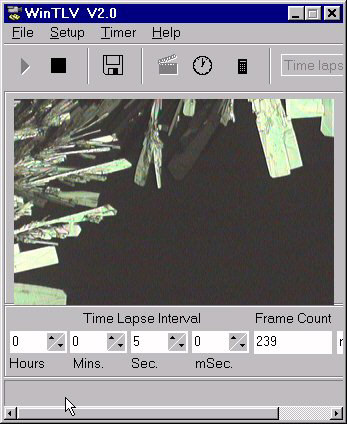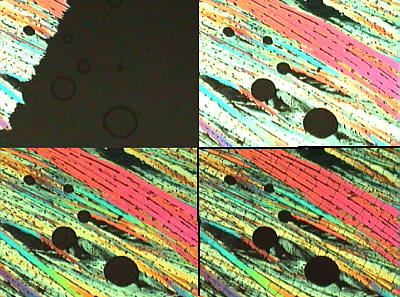The macroscopic and microscopic world offers a wealth of suitable subjects for time-lapse video studies and the results can potentially be very dramatic. If you already own video capture hardware for your computer, there is probably time-lapse software that can work with it, so this type of software offers an easy way for the amateur microscopist to experiment with time-lapse at little cost.
Saving video footage to tape would require a time-lapse video tape recorder which can be expensive, so the digital route seems to offer advantages for the hobbyist where existing computer hardware is used. Especially for web work, where short video clips in small on-screen windows are quite effective and undemanding to create on the PC. The author shares his early experiences below of creating short clips suitable for the Web, in case it's of interest to other amateurs.
What do you need?
If unfamiliar with the general approaches for capturing video directly to the PC, you may wish to check the Micscape Library in the 'Techniques' section, where contributors with various equipment share their experiences.
Computer: a high performance PC isn't needed.Full screen video capture to a PC usually requires high performance hardware, but video capture in small 'windows' is achievable on even the most modest PC (e.g. the authors!). Although short video clips won't be of the highest quality, they are exactly the sort of clip that can work well in a web page. (See the 'Movies' section of Microscopy UK for a wide variety of video clips in various formats).
Video capture hardware/software
If you already own some sort of video capture hardware for the PC (e.g. web cam, security camera/ capture card), check the makers documentation or web site to see if time-lapse software is available. Even if dedicated software isn't available, third party software that can use the video input within a Windows (and probably Mac) environment is available on the Web e.g. 'WinTLV' from C3Systems. In fact the author preferred WinTLV to the free software available for the Hauppauge TV card which the author uses for video still and movie capture.
Note added Oct. 2003: The 'C3 Systems' WinTLV link has been removed as it no longer works and the author is unsure whether WinTLV is still available. Software with time lapse features mentioned in the newsgroups are downloadable from http://www.scenalyzer.com/main.html and http://www.bitwelder.karoo.net/ so readers may wish to try these.
Some of the digital still cameras and the Intel Play computer microscope I believe also have time-lapse features built in.
Time-lapse video software such as 'WinTLV'® right by C3 Systems is very easy to use. The video capture area and usual capture features can be set in the menu and the time interval set in the boxes shown. The video input continues to be shown in real time, which is useful for tweaking e.g. focus between frame captures. For long sessions, this software can work in the background while using the PC for other tasks. The frame captures are sent straight to an avi file (using compression if desired). This ensures that even for day-long time-lapse captures, relatively little disc space is used. The master avi file can then be edited and further compressed for web page use if desired.
A neat feature of this software is a calculator icon which allows a suitable time-lapse interval to be calculated for the desired final footage.

(Video window shows Vitamin C growing from aqueous solution, between partially crossed polars).
Some time-lapse software e.g. the freeware
Timelapse v1.3
for the Hauppauge series of capture cards, saves each frame as a still
image file and can use large amounts of disk space for uncompressed formats
(e.g. bmp). Post capture assembling to a video file with software like
bmp2avi
is also required. Although
if stills rather than video is required, the quality is potentially higher.
| Creating time-lapse footage requires lots of patience, if the author's experiences are anything to go by! I was hoping to create a macro sequence of a small willowherb flower (Epilobium sp. 1cm across) opening from bud. I chose to set the frame capture on the righthand of the two buds - which sat there all day not opening. Only too late did I realise the bud to the left (now in frame but not at the time) did exactly what I was hoping for! I'll add some footage here during the month if I succeed. |

Video still from security camera with 50mm SLR lens using the macro set-up shown below. |
| The author's usual set-up
for simple video macroscopy is shown right and which also served for the
trial time-lapse studies of the flower opening shown above. An old video
security camera (C) on tripod is used with the output sent to the PC. The
book provides the black textureless background and microscope lamp (L)
with white reflector (not shown) the lighting.
Safety note: Lighting for time-lapse work could be on for a long time and ideally needs to be a 'cool' light source. The tungsten Russian microscope lamp used here does get very hot, but the all-metal enclosure is designed to dissipate this heat. Leaving hot light sources unattended, especially for time-lapse studies, is not recommended. Light sources with heat sensitive enclosures e.g. plastic should not be used. Note added after publication. After further use I don't think the Russian lamp and possibly other microscope lamps are suitable for time-lapse where the lamp is left on for long periods. The author's Russian lamp gets too hot, the lamp bulb overheats/flickers and the cabling may be at risk. Microscope lamp bulbs are also often expensive. See web link in footnote where suitable lamps for time-lapse are discussed. |

The macro subject, in this case a small willowherb, is held in a plastic sample tube of water supported on a Petri dish with plasticine. This allows the subject to be adjusted with ease. |
Thoughts so far ...
A lot of fun can be had with time-lapse software, but if like the author you haven't tried time-lapse before and have a go, don't be disheartened if early trials aren't very successful. The adage in all filming of 'know the subject' probably applies even more so with time-lapse. It's worth trying a few 'dry runs' to get a feel for how a sequence occurs in real time in order to judge what filming area (and hence magnification) is required and depth of field. This will also allow a suitable time-lapse interval to be calculated for smooth looking footage of the desired length.
Time-lapse software is also very useful for real time video capture to a PC of modest capabilities. For example, with WinTLV a capture rate of four frames a second can be set, which is very undemanding of the PC cf the full 15+ frames a second that some real time video capture software will require. To keep file sizes down, video clips for the Web often work surprisingly well to give a flavour of a moving sequence by using small frame rates and with auto-looping of the clip.
The author plans to try and capture the moment of hatching of organisms like water fleas and tadpole shrimps from resting eggs using time-lapse software. There's the potential for a lot of wasted footage up to the point where the egg starts to hatch. But there is software on the Web, primarily for security use, which only starts the image capture when motion in a preset area of the frame occurs (e.g. for the Hauppauge cards). This seems a neat way to start filming unattended at the exact moment e.g. when an egg starts to hatch. If you have used 'motion detection software' for video macroscopy or microscopy, the author would be very interested to hear of your experiences.
If you have a go at time-lapse and create some footage, we would be pleased to share it on Micscape.
Comments to the author Dave
Walker welcomed.
Useful links. Since writing the article, Ed Kinsman, who has extensive experience of time-lapse studies, e-mailed the author and made some very valuable suggestions. His web site http://www.sciencephotography.com includes an excellent introduction to time-lapse techniques using film, video and image capture and is illustrated with stunning examples.
